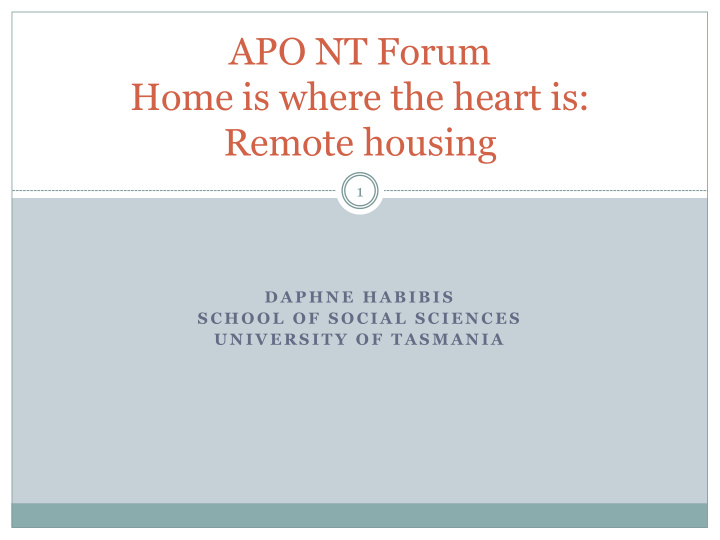



APO NT Forum Home is where the heart is: Remote housing 1 D A P H N E H A B I B I S S C H O O L O F S O C I A L S C I E N C E S U N I V E R S I T Y O F T A S M A N I A
Indigenous Housing Policy 2 Since the 1970s there has been a shift from policies of self-determination to ones of mainstreaming in housing management and housing service delivery in urban and remote areas This has been accompanied by increased demands for behavioural change, e.g. rent payments, home maintenance End of tied/specified funding for urban Indigenous housing Significant investment in remote housing but accompanied by withdrawal of funding from many ICHOs
3
Challenges of Service Delivery 4 Land tenure Access to facilities providing safe workplaces Recognition of traditional ownership Communication difficulties: language, distance, culture Politicised context Differences in connection to Community governance place, housing practices, Housing shortages meanings of house, home, Absence of a housing market land, tenant, cultural Distance to regional centres practices e.g sorry business and between settlements, poor Impact of extreme weather transport networks events on occupancy and Availability of skilled housing access management and maintenance Large household sizes workforce – difficulties of Cost of living supervision Access to other services Adequate IT equipment and New requirements for tenants infrastructure
A Flexible and Diverse Aboriginal housing system 5 Strong evidence base that the diversity of Aboriginal communities, the cultural differences and the remote contexts requires housing policies and services that are: Flexible in terms of policies and the way services are delivered Adaptive in terms of who the providers are
Tenancy Management Arrangements 6
AHURI Study 7 Stage 1: 2013 Identify progress of NPARIH reforms and reasons for different mix of services delivery housing in remote communities; Establish feasibility for further investigation Stage 2: 2014-5 Assess tenant satisfaction; cost analysis and sustainability of service delivery post-NPARIH Methods: Investigative Panel, case studies, interviews, survey. Ngukkur, Northern Territory Cooktown, Wujal Wujal, Queensland Amata, Mimli, Pipilyatja, South Australia Bayulu, Yakanarra, Western Australia Kun unurra, Western Australia Researchers: Daphne Habibis (UTAS) Rhonda Phillips (UQ), Angela Spinney (Swinburne) Peter Phibbs (Sydney)
Achieving Positive Outcomes 8 Evolving nature of Rent setting and collection: arrangements for service remain challenging areas delivery Pressures on head tenants Some improvements in Employment: vital to have housing conditions but experienced staff, OH&S crowding remains a concern Indigenous employment: Concerns that budget targets, cultural knowledge constraints mean R&M and commitment, cultural limited to high priority security maintenance raising Tenant property care: concerns about protection of wilful damage/wear & tear assets and tenancy standards
Policy Lessons and Future Planning 9 Tension between national policy context of mainstreaming and requirement for flexible policies that take account of local contexts a range of models of housing delivery importance of building trusting local partnerships and ensuring strong inclusion/participation of Indigenous tenants, community members and organisations need to develop and implement policies incrementally Resourcing capacity building for good governance within local providers and consultation bodies Ensuring the gains from NPARIH extend beyond 2018
Recommend
More recommend